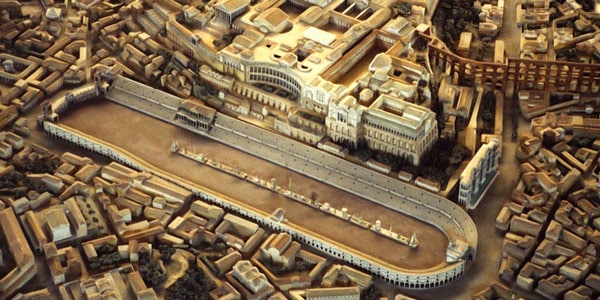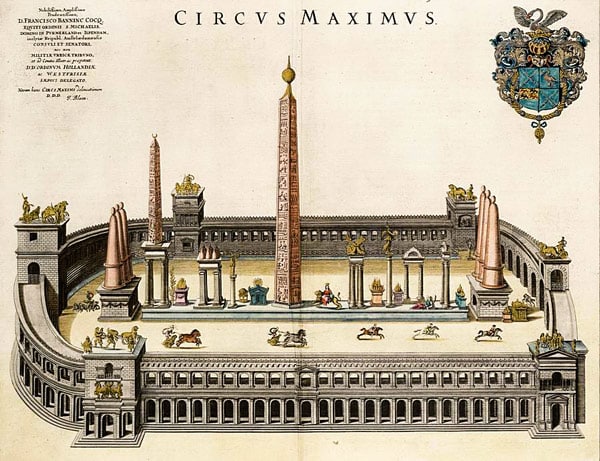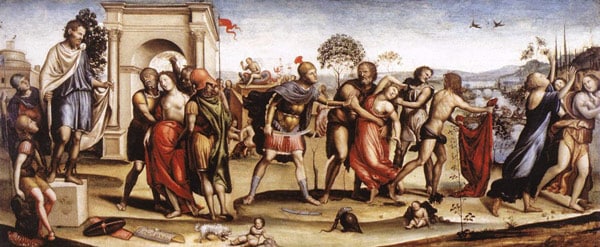The Circus Maximus (Circo Massimo) is the largest hippodrome in Ancient Rome, located on the left bank of the Tiber River, between the Palatine and Aventine hills, practically in the center of the modern city.
Page Contents
Name
The name Circo Massimo – Circus Maximus – comes from the Latin Circus Maximus. One of the meanings of Circus is a racing track, a place for horse competitions. In the valley between the hills, races took place for centuries – historians suggest it could have been a seasonal celebration in honor of Neptune the Equestrian.
The first competitions were held in Rome in the 500th year BC under King Tarquin the Proud (Lat. Lucius Tarquinius Priscus). Chariots, harnessed by teams of four horses – quadrigas – raced from the start straight ahead. Upon reaching the end of the valley, they turned around and galloped back, trying to finish first.
The rules changed in the 2nd century BC due to constructing an aqueduct in Rome around 146 BC. It was laid along the valley floor, digging a tunnel 4.5 meters high and 2.5 meters wide. Along the entire racing track, a mound extended, which was not leveled but instead used to send the quadrigas around in a circle. Thus, the second meaning of the Latin word Circus – circle – was fully justified, and then the Italian word Circo (Circus) appeared. The Circus was indeed “massimo” – ample, the size of an entire valley, 150 meters wide and more than six hundred meters long.
Description
Descriptions of the Circus vary across different periods of its development. Initially, spectators wishing to watch the horse races were seated directly on the slopes of the hill. Gradually, the first structures appeared: benches for the most respected and wealthy citizens, a wooden starting gate, and stalls for the horses.
During its heyday, which coincided with the reign of the first Roman emperors, the Circus Maximus was one of the most impressive structures in Rome. Gaius Julius Caesar in the 1st century BC rebuilt it, expanding and lengthening the arena and digging a canal around it.
Now, thanks to the new dimensions (118 m in width and 621 m in length!), it could simultaneously accommodate 12 quadrigas.
Around the stadium, a fence was erected, wooden stands for the patricians, and tiers for the more straightforward public were built. There were 150,000 seating places, and their number more than doubled in the following centuries. At least as many fans experienced the standing of the competition.
At one end of the arena were three towers, the central one with gates for entry inside, to the two others, stalls for horses – the carceres – were attached in a semicircle. Winners left the Circus through gates on the opposite side.
Along the arena, down the center, ran a narrow platform decorated with two ancient Egyptian obelisks. Both obelisks survived and now adorn in Rome the Piazza del Popolo and the square in front of the Lateran Palace (Palazzo del Laterano).
On both sides, the platform ended with curves with columns shaped like cones – the metae. The chariot race started from one of the metae, to finish at the opposite end of the arena after seven laps. The laps had to be counted; for this purpose, two stands, each with seven spheres, were installed on the platform. Over time, small fountains in the form of dolphins – sea horses, the patron of the racing track Neptune, appeared nearby.
How to Get There
You can reach the Circus Maximus on foot in 5 minutes from the Roman Forum (Foro Romano) and the Colosseum (Colosseo), and from the Palatine Hill directly to the Circus leads the Scala Caci staircase. It commemorates the tenth labor of Hercules. It is said, this is precisely where the fire-breathing, three-headed shepherd Cacus, son of Hephaestus and Medusa, hid two of Geryon’s best cows stolen from Hercules, who was sleeping on the banks of the Tiber. Here, Hercules fought Cacus in a duel and retrieved the stolen goods.
If fatigue takes its toll, the most convenient way is to use the metro and get off at the Circo Massimo station (Line B). You can also take:
- buses No. 60, 81, 75, 160, and 175;
- tram No. 3.
The Legend of the Sabine Women
Historians suggest that the events of the legend of the Sabine women, which became a favorite theme of world culture, unfolded right here, in the valley of the Circus Maximus.
In the time of Romulus, all of Rome fit on the Palatine and was so strong that it could subdue everyone. But there were no women in the city of warriors to continue the lineage. They asked their neighbors for help but were refused, and then the cunning Romulus invited them to celebrate the festival of Neptune, the god of horses, in the large valley at the foot of the Palatine. Among others, the Sabines came, bringing their wives and children. At the height of the festival, Roman youths rushed to abduct the Sabine women.
Their husbands and brothers could not tolerate the insult and soon besieged Rome, but the same women, because of whom it all started, managed to reconcile the men. Thus began unifying disparate fortified settlements on the seven hills into the ancient and eternal city.
 Italy for me From Italy with love
Italy for me From Italy with love




